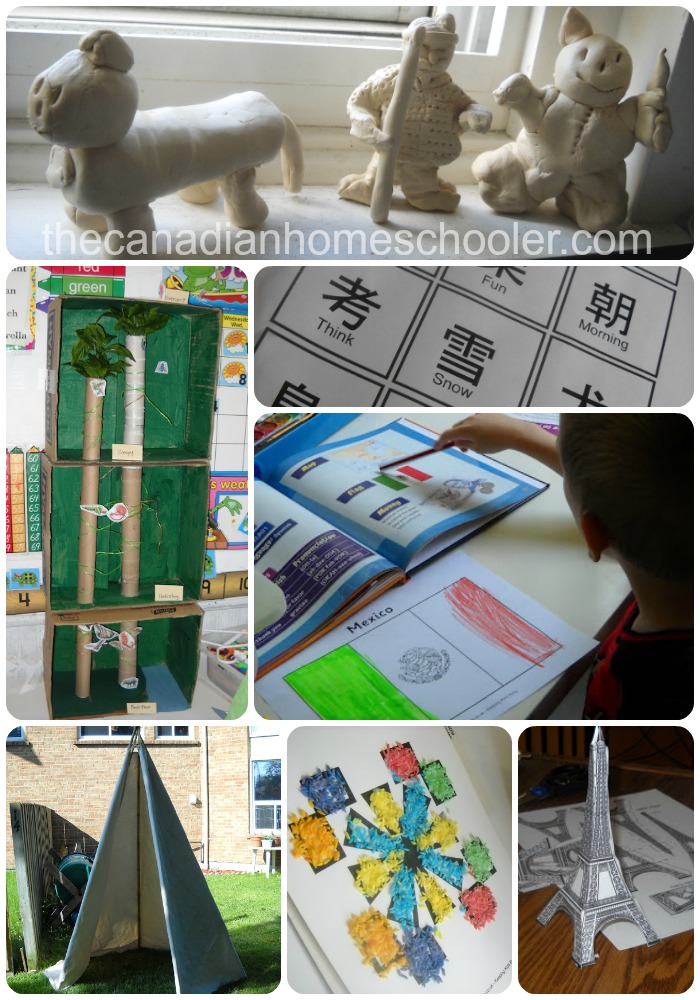Want to teach your children about the world without having to pack your bags? Here are some ideas to create your own homeschool world geography study.

This post contains affiliate links.
Pick The Countries for Your Homeschool World Geography Study
The first step is to decide what places around the world you want to explore and “visit.”
One suggestion is to use a monthly geography focused kit that comes in the mail for your kids. The Little Passports kit gives children the opportunity to learn and explore without having to even leave home! You can choose to travel through the USA or visit the World. There is even a special kit for preschoolers so they can participate too.
Each month, a package will arrive from Sam & Stella as they travel around on their journey. The package will contain a letter and photo, codes to access an online section of their website for games and activities, some worksheets and even a souvenir. It’s a fun little activity pack!
Once you know where in the world Sam and Stella are mailing you from, you can build a bigger study of the area they are visiting, making their trip around the world a great opportunity to learn more about cultures and geographical history.
Another option is to do it yourself. All you have to do is make a list of the countries that you’d like to visit on your journey and build from there. When we did our world trip several years ago, we did: Canada, US, Mexico, Brazil, Kenya, Egypt, France, Britain, Scandinavia, Russia, China, India, and Australia – one a week through the summer.
What To Include On Your Trip
1. Grab some library books and videos all about that country. Depending on the age of your kids, look for ones with great photos and maps so your kids can “see” that country. Travel guide documentaries are terrific.
2. Colour a map and the flag from that country. Mark the capital city and other important places. Find the country on the world map and compare its relationship to where you live. Learn more about what the flag symbolizes (usually the colours and the symbols you see on flags represent something of importance for that country or culture.)
3. Make and/or taste an ethnic food. Look online for recipes that you can make. Sometimes you can find cookbooks for kids based on cultures at the library. Also, be sure to check the ethnic foods sections at the grocery store. When we did a trip around the world a few years ago, we found a box of Indian speciality foods, tried some sushi, and other cultural treats. We made Mexican hot chocolate, fried some plantains, and taste tested some brie cheese with grapes and baguettes.
4. Focus on something unique about the country. Each culture and place has something special and different than another. Some examples:
- Brazil: Rainforests
- Egypt: Pyramids
- France: Eiffel Tower
- United Kingdom: Loch Ness Monster
- Kenya: Elephants
- China: Terracotta Warriors
5. Use online resources: listen to music, watch a travel video, look for webcams, play online games, read websites, and more.
There are some great online websites that play music from just about any country, and if that fails – there’s always Youtube.
Webcams of various places can be a lot of fun. You can watch for Loch Ness, stare at an African Watering Hole, see the view from the Eiffel Tower, and see Niagara Falls. I recommend checking out EarthCam for many options.
A cute video travel series for kids is Are We There Yet? They are short clips of some other kids on their world travel adventures.
6. Great hands-on and crafty. No matter where you are exploring there are plenty of opportunities to do hands-on activities and crafts. Make paper lanterns, pinatas, tribal shields, castles out of manila folders and printed clip art, rangoli (symmetrical rice art), or build a teepee. Try Chinese calligraphy, mummify apples, papercraft famous buildings, make masks for Carnival, and design your own embossed metal art. There are countless opportunities to create and learn when exploring the world.
7. Check out the money. Little Passports offers a set of 20 world coins you can use to study up close or in person, or you could either ask your friends and family for any they have around. Another option is to check out money online. It’s amazing how different and unique each country’s money is. Be sure to compare value with your own money.
8. Listen to and try out the language. Many times the idea of a foreign language can be just that to our kids – foreign. Having the opportunity to listen in on a conversation such as a radio show or even on a “learn to speak” website can give kids an ear-opening experience.
9. Do a summary project. When we did our adventure, at the end of each country, we put all our work together, we completed a simple worksheet (like this one: https://layers-of-learning.com/country-fact-sheet/) and put all our work into a binder to keep. I’ve seen some other terrific projects such as lapbooks, bristol board presentations, blogs, photo montages, and more. There’s no limit other than your imagination!
Some additional resources:
- Printable Canadian Passports
- Country stickers to add to your passports
- Little Passports
We loved travelling around the world from home. It’s a great way to build a fun homeschool world geography program.
- How to Keep a Toddler Busy While Homeschooling - March 21, 2024
- 25+ Things Your Kids Learn From Video Games - March 20, 2024
- 10 Words For New Homeschoolers - March 20, 2024



I would love to visit paris!
Would like to see the rest of Canada.
There are so many places I would love to visit but top three are French Polynesia, Scotland , and Ireland
Our family was from Scotland so it would at someday day be inspiring to go & visit our family!
I would love to visit Greece.
I’d love to visit Scotland!
I would love to visit Holland!
The UK for sure! 🙂
I’d love to travel with my family to Newfoundland, Northern Canada (like really far north) or New Zealand.
Besos, Sarah
Journeys of The Zoo
I’ve always wanted to visit Italy but Scotland and Holland are high on my list too
Europe! All of it!
Italy!
I would love to go to Scotland.
I would love to go to China. I want to walk the Great Wall and climb mountains there.
I would love to visit Australia.
I have always wanted to visit Greece!!
France would be so great!
My top three are Ecuador, Ireland and Italy 😀
We’ve been studying Egypt this year and that is definitely a top choice for countries to visit!
I’d love to visit the British Isles and do some family genealogy! 😉
Europe, so many fascinating countries to see there!
The Netherlands. DH’s family history is there.
I would love to go to Germany!
Current world events aside, I would love to visit the pyramids in Egypt!
I’d love to visit Scotland.
There’s lots of places I’d like to go, but travelling all around North America by vehicle is one thing I’d love to do before the kids are out of the house.
france. i think it sounds like the best part of europe.
I’d love to visit Egypt!
I would love to visit Thailand again!
I would like to see more of Canada, have only seen areas of BC and Ontario for most part. Or go to Holland!
Thank you for this! I’m planning to study Finland and Scotland with my kids this year; their grandparents were born in those countries so I want them to learn a little bit about their roots. Your ideas and resources are super helpful!